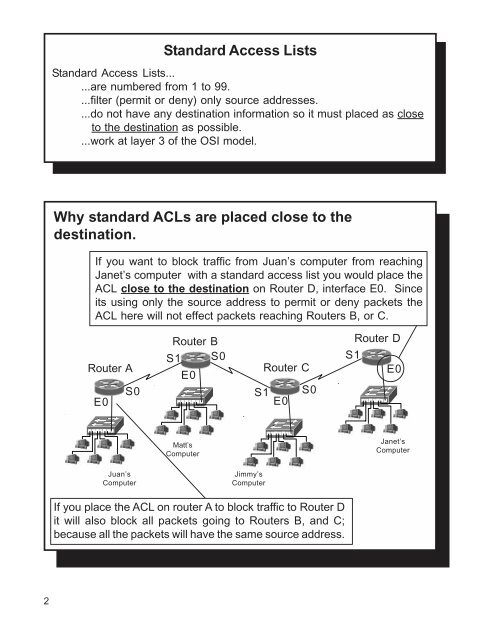Access Lists Workbook - The Cisco Learning Network
Access Lists Workbook - The Cisco Learning Network
Access Lists Workbook - The Cisco Learning Network
You also want an ePaper? Increase the reach of your titles
YUMPU automatically turns print PDFs into web optimized ePapers that Google loves.
2<br />
Standard <strong>Access</strong> <strong>Lists</strong><br />
Standard <strong>Access</strong> <strong>Lists</strong>...<br />
...are numbered from 1 to 99.<br />
...filter (permit or deny) only source addresses.<br />
...do not have any destination information so it must placed as close<br />
to the destination as possible.<br />
...work at layer 3 of the OSI model.<br />
Why standard ACLs are placed close to the<br />
destination.<br />
If you want to block traffic from Juan’s computer from reaching<br />
Janet’s computer with a standard access list you would place the<br />
ACL close to the destination on Router D, interface E0. Since<br />
its using only the source address to permit or deny packets the<br />
ACL here will not effect packets reaching Routers B, or C.<br />
Router B<br />
Router A<br />
S1<br />
E0<br />
S0<br />
Router C<br />
E0<br />
S0<br />
S1<br />
E0<br />
S0<br />
Juan’s<br />
Computer<br />
Matt’s<br />
Computer<br />
Jimmy’s<br />
Computer<br />
If you place the ACL on router A to block traffic to Router D<br />
it will also block all packets going to Routers B, and C;<br />
because all the packets will have the same source address.<br />
S1<br />
Router D<br />
E0<br />
Janet’s<br />
Computer

















